Breaking Boundaries: Jazz, Pop and Rock & Roll in Japanese Cinema
Jasper Sharp is a writer and curator specialising in Japanese cinema. His books include The Historical Dictionary of Japanese Cinema and Behind the Pink Curtain, a fascinating history of Japanese’s Pink Film and Roman Porno genres. As part of the Red Bull Music Academy in Tokyo, we asked Jasper to pen an essay on the intersection of the Japanese music industry and its cinema counterpart. What follows is an overview of the jazz, pop, and rock superstars that made an impact on screens across the island nation – and beyond.
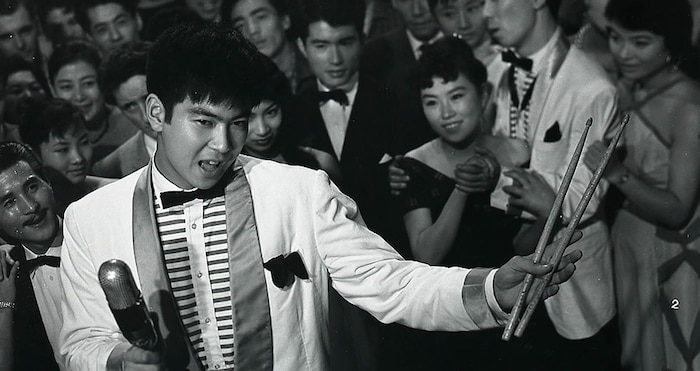
Dividing Lines
Wartime Demons, Jazz and the Culture Clash
Through the U.S. military bases during the occupation and beyond, jazz, a Western import strongly identified with American culture and thus banned by the wartime government, returned to Japan in the post-war years. The environment for this renaissance is evocatively captured in a 2004 film called Out of This World (Kono yo no sotoe) directed by Junji Sakamoto, in which Peter Mullen stars as the manager of the “Enlisted Men’s Club,” a smoky lounge bar circa 1947 where posted American G.I.s are offered the opportunity to let down their hair.
Here, he nurtures the ambitions of a locally-sourced ensemble, named The Lucky Strikers (after the American cigarette brand), all of whom embrace this radical foreign musical form as a means of exorcising their personal wartime demons. Despite a tendency towards melodrama, the film does an admirable job in conveying the racial pecking order of the era, in which music is seen as bridging the cultural dividing lines between not only the occupiers and the locals, but also the black and white GI’s. This clash between cultures and ethnicities would play a major role in fuelling Japan’s rock & roll revolution.
The 1950s were considered a Golden Age for Japanese cinema, marked by an explosion in production, with the number of Japanese films released first topping the 500 mark in 1956. Strict import quotas throughout the ’50s, as well as local tastes, meant the majority of local audiences favoured the local product, with foreign releases only capturing a third of the box-office share.
Nevertheless, as the Occupation forces departed, the major Hollywood studios all moved in, establishing branch offices in the nation’s capital, meaning that roughly three quarters of the foreign films seen in Japan were American. Hollywood films were bigger, bolder and brighter than anything the local industry could muster, and for a generation eager to divorce themselves from the mindset of their immediate forebears, they pointed to new ways of living. Key to this embracing of a bold new age was music.
International Outlooks
Ryoichi Hattori and the Post-war Jazz Boom
Among the first domestically-produced movies to showcase jazz was Shintoho’s Tokyo Cinderella (Tokyo Shinderera musume, 1954), which came graced with the subtitle “Jazz on Parade, 1954.” This frothy musical comedy told the tale of a philandering third-rate nightclub magician who takes in the grimy-faced orphaned son of a deceased magician friend as his assistant. In true pantomime fashion, the canary-voiced waif turns out to be a she – a certain Izumi Yukimura to be precise, a phenomenally popular singer who had made her recording debut just a year previously. Also worth mentioning is that the film also sports an early appearance by the pudgy comedian and actor, Frankie Sakai, who himself had started off his career jazz as a jazz drummer playing on U.S. military bases.
Tokyo Cinderella’s director, Umetsugu Inoue, remains a largely overlooked figure in international overviews of Japan’s cinematic history, which have by and large tended to neglect the industry’s significant musical output. Another reason is that he tended to skip between studios a fair amount. During a leaner period in Japanese cinema, between 1966 and 1970, he also moonlighted for Shaw Brothers in Hong Kong, where he remade some of his more successful earlier films, with vivacious musical numbers courtesy of another veteran from Japan, the jazz composer Ryoichi Hattori.
Hattori is hailed as the main man responsible for Japan’s post-war jazz boom, although his earliest film credits stretch back to 1936. During the late wartime period, Hattori’s work had taken on a more nationalistic bent. His more frivolous ditties about the pleasures of modern life, such as the 1939 hit tune “From a Cup of Coffee,” about the joys of “Jazz kissa” café culture, made way for a more controversial cultural legacy, notably the haunting melody of “Suzhou Serenade” (Soshu yakyoku).
This song had been performed by Li Xianglan, one of the top female stars of the Japanese-operated Manchuria Film Association, based in the puppet state of Manchuria (referred to by the Japanese as Manchukuo) on the Asian mainland. Promoted as a genuine Chinese actress sympathetic to Japan’s imperialist ambitions, Li Xianglan was actually Yoshiko Yamaguchi, the daughter of a Japanese employee of the South Manchuria Railway Company. In the aftermath of the war, she faced execution for treason by the Chinese government, escaping back to Japan after it was revealed she was not actually a Chinese national. In the West, she is a better known as Shirley Yamaguchi, the handle under which she appeared in a number of Hollywood films.
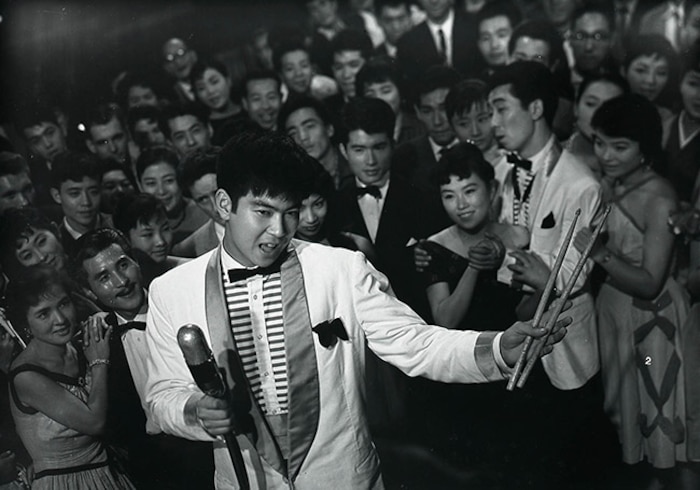
Land of the Rising Stars
Baroque Exotica, Wide-screen Colour and Sun Tribes in the Late ’50s
Other revolutions would hit the Japanese big screen throughout the 1950s, namely the introduction of colour and widescreen scope formats, which were ideally suited to the musical genre’s prioritization of extravagant display and cosmopolitan exoticism over narrative sophistication. Inoue himself directed Nikkatsu’s first colour film, Far Off of Green (Midori haruka ni, 1955), while Tokyo Cinderella’s Yukimura was partnered with two other singing starlets, Misora Hibari and Eri Chiemi, in a series of Eastmancolor musicals directed by Toshio Sugie for Toho that included the company’s first widescreen production On Wings of Love (Oatari sanshoku musume, 1957), also known as Three Dolls Make a Big Hit.
Such gaudy proto-pop vehicles are probably best regarded as more in line with the kind of films Doris Day was making during the 1950s. It was Inoue, however, that really showed what could be done with the widescreen format with his altogether more anarchic The Man Who Causes a Storm (Arashi o yobu otoko, 1957), also known as The Stormy Man. The film ranked as the 11th top-grosser of the decade and featured Nikkatsu’s rising star, Yujiro Ishihara, as Shoichi, a headstrong ex-con who gets a lucky break as a jazz drummer, in the process inviting the ire of the former king of the scene when he is taken under the wing of a female manager, Miyako (played by Ishihara’s frequent onscreen paramour, Mie Kitahara, who retired from acting after they married in 1960). It’s a typical loner take on the mob set up, although with the latter represented by the music industry and the critics in their pockets (with their own dubious gangster connections). There’s also a heady sexual undercurrent to spice things up, with Miyako grooming her young protégé as he pounds upon the skins like a jackhammer.
To modern viewers, the sheer brio of its performances and the exotic cabaret floorshows that accompany them evoke a hedonistic world in which music is not only symptomatic of a new era of youthful rebellion and the embracing of American culture, but a rapidly modernizing Tokyo. Montages of superimposed neon signs became something of a specialty of this director, in keeping with a meticulous compositional approach concerned with filling every nook and cranny of the screen with a dazzling riot of colour and baroque set décor that approached abstraction in his later work.
Ishihara not only starred in the film, but performed its swinging title tune, replete with a plethora of drum rolls and released to great commercial acclaim by Teichiku Records.

It is seldom regarded as such nowadays, but The Man Who Causes a Storm represents a pivotal work in Japanese cinema, perfectly encapsulating the riotous, go-getting spirit of its age. In this regard, the sub-story in which Shoichi tries to win back the affections of his disapproving mother, while his altogether more serious and conscientious brother embarks on a classical career composing a Gershwin-inspired orchestral “City Symphony” to celebrate the dynamism of the capital, seems particularly pertinent, their reconciliation at the coda suggesting an acceptance of both new foreign musical forms. The film also draws heavily on Ishihara’s star persona, in which the lines between onscreen and offscreen were blurred.
Ishihara had got his acting break in a small part in Tarumi Furukawa’s Season of the Sun (Taiyo no kisetsu, 1956), a scandalous adaptation of a 1955 novel focused on a tempestuous summer love affair between a hot-headed college boy and a pristine Ginza girl, whose frank depictions of teen sex and abortion caused a storm of its own among the nation’s more conservative elements. The original book was written by Yujiro’s elder brother, Shintaro Ishihara, and launched not just two incredibly successful careers, but an entire literary and cinematic genre known as taiyozoku, translating as “Sun Tribe.”
An interesting sidenote: the elder Ishihara, Shintaro, would eventually retreat to another sector of the showbiz world, politics, where he achieved a notorious success as the outspokenly conservative governor of Tokyo (between 1999 to 2012): an outcome that seems quite at odds with the racy literary works with which he first emerged into the spotlight.
In the ’50s, rock & roll was ringing in the ears of Japan’s youth, initially introduced in a decontextualized and diluted form with Peggy Hayama’s cover version single of Bill Haley’s “Mambo Rock” in October 1955, followed shortly after by a rendition of “Rock Around the Clock,” sung by one of the Three Dolls of Toshio Sugie’s films, Eri Chiemi. The Japanese releases of such revolutionary youth movies as Rebel without a Cause (Nicholas Ray, 1955) and Blackboard Jungle (Richard Brooks, 1955) also caused significant ripples. It was within this context that the taiyozoku culture emerged, with a generation of middle-class bebopping baby boomers riding the waves of Japan’s emergent affluence following the hardship of the post-war period, eager to escape from traditional dogma and actively indulging in a new consumer culture of movies, music and magazines.
With music providing the backdrop rather than the main attraction to the late ’50s taiyozoku boom, Yujiro Ishihara’s songs tended to be in the more toned-down enka vein, with their traditionally-styled Japanese laments combined with Western instrumentation often compared to American country and western. His hits, both musical and cinematic, included the accompanied croonings to his turn as the kind-hearted airline captain of Crimson Wings (Kurenai no tsubasa, Ko Nakahira, 1958), who selflessly volunteers on Christmas Eve to pilot a Cessna on a mercy mission, and the theme to the Koreyoshi Kurahara-directed Ginza Love Story (Ginza no koi no monogatari, 1962).
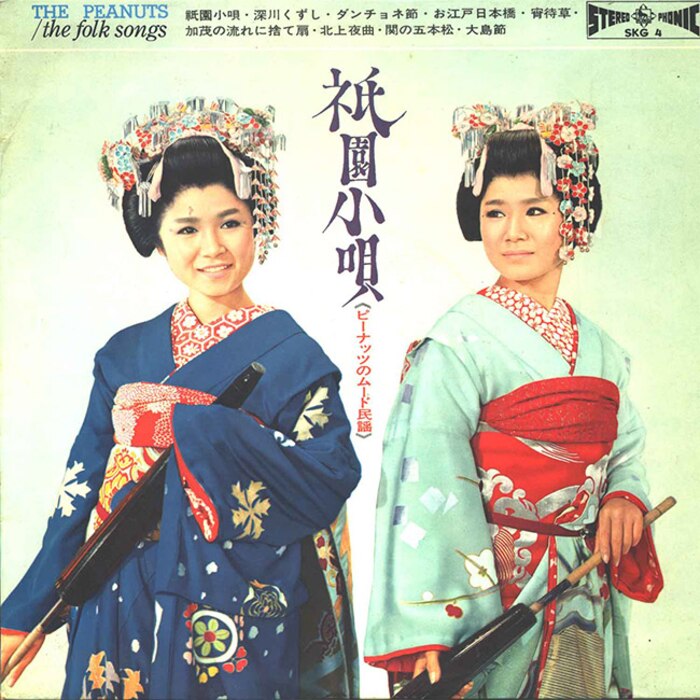
Crossing Borders
Rockabilly, Sukiyaki, “Young Guys” and an Ainu Western B-movie: Pulp Cinema in Japan in the ’60s and ’70s
Cinema was by no means the only conduit for the influx of American music and culture that Japan would claim for its own. Between June 1959 and March 1970, Fuji TV provided audiences with their first dedicated rock & roll show, The Hit Parade. The host was half-British reigning star of the emerging rockabilly scene, Mickey Curtis, with backup provided by the preternaturally perky The Peanuts, consisting of identical twin sisters Emi and Yumi Ito.
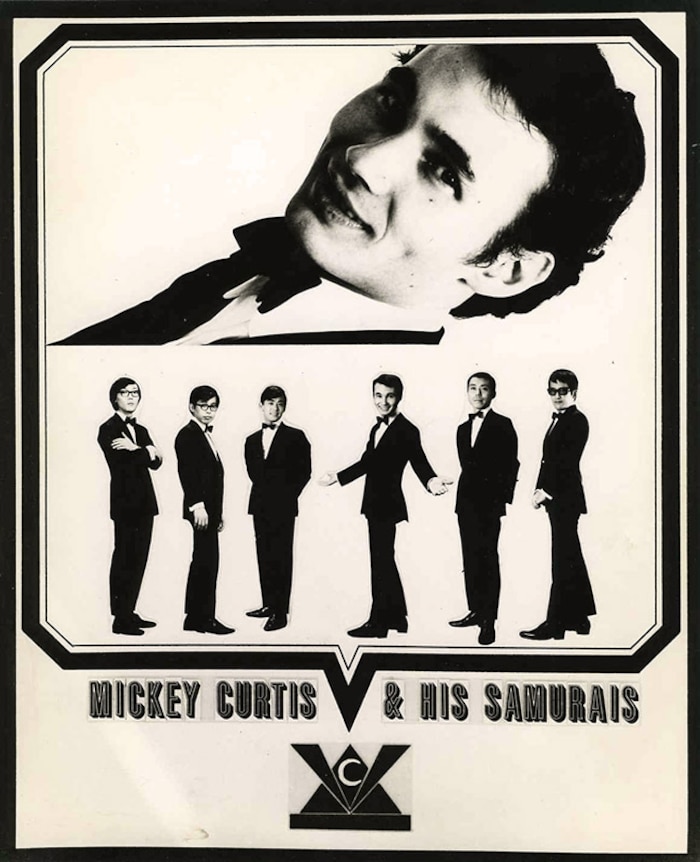
Beyond television and music, with which he achieved a degree of international success in the late ’60s with the psych-rock outfit Mickey Curtis & The Samurai, Curtis also carved out a niche on the big screen, putting in an appearance in Kon Ichikawa’s classic anti-war film Fires on the Plain (Nobi, 1959). His not-quite-Japanese demeanour was later used to good effect in a number of films made in the 1990s that presented a more multicultural portrait of the country’s denizens, including Masato Harada’s Kamikaze Taxi (1995) and several titles by cult director Takashi Miike. The Peanuts too, were a consistent presence throughout the ensuing decade, through their repertoire of original numbers, foreign pop hits and up-tempo re-workings of traditional Japanese songs, and also appeared in some half-dozen features. Viewers from outside Japan may best recognize them as the Lilliputian duo abducted from their South Seas island home in Godzilla director Ishiro Honda’s monster moth movie Mothra (Mosura, 1961) for Toho.
Back at Nikkatsu, the studio that had provided The Peanuts with their first movie outing in Tan Ida’s Pretty Flower (Kawaii hana, 1959), in which they performed the title song, was bolstering its “Diamond” line of screen tough guys, with names such as Hideaki Nitani, Tetsuya Watari, Jo Shishido and Akira Kobayashi. The chisel-jawed Kobayashi, known affectionately as Mighty Guy (maito gai), particularly embraced the recording medium alongside his screen turns, with numerous albums released on the Crown Records label throughout the decade featuring his vocal talents and his photographic portrait, often in character, emblazoned across their covers. In his best-known early roles, he played the guitar-strumming nomad at the heart of the nine film Wandering Bird (Wataridori, 1959-62) series, which appropriated the tropes of the Western B-movie as he wandered from town to town across Hokkaido, clad in a black-tasselled leather jacket and red kerchief, fighting for the rights of the indigenous Ainu people and leaving a trail of broken hearts behind him.
Such titles fit within the studio’s new “Mukokuseki Action” line, meaning “Borderless Action.” The films were clearly made in Japan, although their plots and iconographies were a stylistic grab-bag drawn from the international language of pulp cinema, not a million miles away from the approach adopted by Tarantino decades later.
However, it wasn’t just Nikkatsu. Toho made a whole raft of musicals in the ’60s featuring the jazz band Hana Hajime and The Crazy Cats, with entries including Kengo Furusawa’s Japanese Age of Irresponsibility (Nippon musekinin jidai, 1962) and Operation Crazy (Kureejii daisakusen, 1966), their madcap adventures punctuated with jazzy fanfares mixed with Western and Japanese pop. Another of Toho’s popular lines was the Young Guy (Wakadaisho) series, starring Yuzo Kayama, the son of a movie actor, Ken Uehara, and a popular singing star in his own right.
Toshio Sugie took the helm for the first two entries in the 18 film entries, Young Guy at University (Daigaku no wakadaisho, 1961) and Young Guy in Ginza (Ginza no wakadaisho, Sugie Toshio, 1962), with later episodes including Young Guy in Hawaii (Hawai no wakadaisho, Jun Fukuda, 1962) and Young Guy with the Electric Guitar (Ereki no wakadaisho, Katsuki Iwauchi, 1965), the latter’s title reflecting the so-called ereki boom of the era, referring to the vogue for amplified electric guitar music sweeping the nation, within which Kayama was a major player.
By the time Toshio Masuda directed I Look Up When I Walk (Ue o muite arukou, 1962) for Nikkatsu, the taiyozoku boom had already become about as toothless as the contemporary offerings from its English-language rocking & rolling role models, like the Paramount Elvis vehicle Blue Hawaii (Norman Taurog, 1961) or Britain’s pale imitation, The Young Ones (Sidney J. Furie, 1961), starring Britain’s even paler imitation, Cliff Richard.
Actor Kyu Sakamoto’s title song, which served as the inspiration for I Look Up When I Walk, remains the only Japanese pop single ever to top the US billboard charts, under the overseas release title of “Sukiyaki” – the title, referring to the Japanese term for cooking up Western ingredients in an exotic hotpot, itself indicative of the mukokuseki ethos. An instrumental version released in Britain recorded by Kenny Ball and his Jazzmen went even further in airbrushing out traces of its Japanese origins, including, obviously, its lyrics.
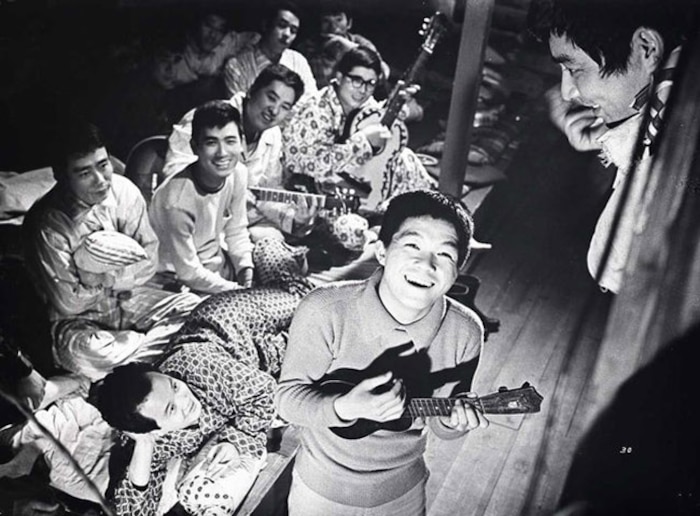
The film itself was a familiar all-things-to-everyone concoction of earlier Nikkatsu titles, featuring crowd-pleasing musical numbers and the odd foray into comedy. Its plot follows the misadventures of two delinquents (with Sakamoto paired alongside Mitsuo Hamada) fresh out of a juvenile detention centre and their subsequent attempts to go straight, with one embarking on a musical career as, in keeping with its antecedents, a jazz drummer. Nevertheless, its disparate elements do coalesce in a surprisingly affecting climax in which the cast members come together for a rousing rendition of the title tune, parading through the streets of Tokyo where they unite outside Yoyogi Stadium, then in the midst of construction for the 1964 Tokyo Summer Olympics.
Nikkatsu marched ever onwards with its cosmopolitan approach. Kenjiro Morinaga directed the singer Teruhiko Saigo in the Taipei-shot Star of Destiny (Hoshi no flamenco, 1966), with its tango-tinged soundtrack again released by Crown. Just ten years after Yujiro Ishihara’s turn in Crimson Wings, it was Akira Kobayashi who got to play an airline pilot, this time en route to Rio (via Los Angeles and New York) in Diamond of the Andes (Sekido o kakeru otoko, 1968), the bossa nova stylings of its signature song, as ever, recorded by its star and released to tie in with the film’s release.
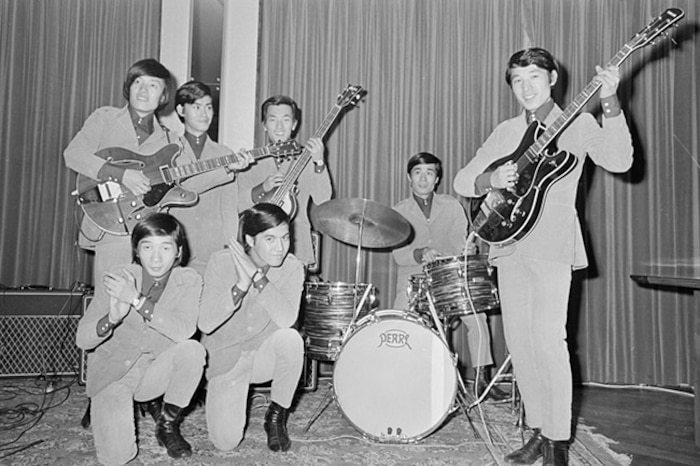
A Band, A Part
Jangle Pop and Beatles Fever
Nikkatsu was quick to cash in on the Group Sounds (GS) phenomenon that exploded (and almost as quickly petered out) shortly after the Beatles legendary four-day stopover in Tokyo between June 29 - July 3, 1966, with a series of musical/comic escapades featuring The Spiders. The band’s Japanese brand of jangle pop was closer to the The Monkees than the original mop-topped Mersey boys. Nevertheless, their fame was enough to see four films released built around the imagined capers of this fun-loving four-piece – all taking their cues from Richard Lester’s takes on the giddy new world of swinging ‘60s stardom with A Hard Day’s Night (1964) and Help! (1965). Not to be pipped at the post, Toho also got in on the act, producing films around the popular beat combos The Drifters and The Tigers, for example in Invitation to Get Flamboyant (Za Taigaasu: Hanayaku naru shotai, Kunihiko Yamamoto, 1968).
Few of these bands made it through the end of the decade, although The Tigers’ androgynous frontman, Kenji Sawada (known affectionately to his fans as Julie because of his unnatural obsession with Julie Andrews) went on from these early roles to lead a successful career as a solo singer and actor, featuring in, among many other high-profile screen outings, Mishima: A Life in Four Chapters (1985), Paul Schrader’s biopic of Japan’s disgraced literary giant Yukio Mishima.
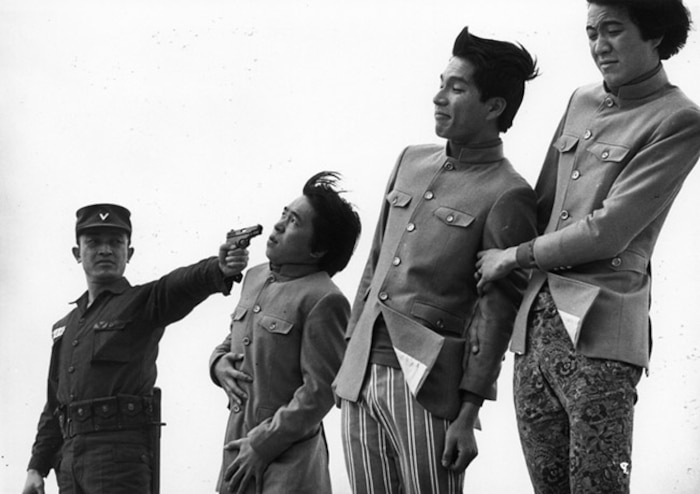
Inside Out
New Wave Cinema Reacts to Choreographed Group Sounds
One didn’t have to look so far overseas to realize that both socially and culturally, Japan was very much embedded in events unfolding in a wider and increasingly more turbulent world. It was the arch-cynic and leading light of Japan’s New Wave cinema, Nagisa Oshima, that would drop the mic on the Group Sounds scene however, with his Three Resurrected Drunkards (Kaette kita yopparai, 1968) starring an altogether more leftfield outfit known as The Folk Crusaders. These legends of the Kansai underground formed while students in 1965, but after losing two of the original five members, had already split up by the time Oshima embarked on his production.
One of three titles directed by Oshima released in 1968, the film, which stars the trio of Kazuhiko Kato, Osamu Kitayama, Yoshio Hiranuma, is a textbook example of the director’s strategy of taking a salient cultural phenomenon and turning it on its head, subverting its template and modes of representation for political comment.
Before their split, The Folk Crusaders had released their best-known song, “Imujingawa,” a melancholy ode to the Imjin River that flows between North and South Korea. Three Resurrected Drunkards was one of three films Oshima made around this period, which include A Treatise on Japanese Bawdy Songs (Nihon Shunka-ko, AKA Sing a Song of Sex, 1967) and Death by Hanging (Koshikei, 1968) that explored Japan’s colonial legacy in Korea and its treatment of ethnic Koreans living in Japan.
Though Three Resurrected Drunkards is clearly a riff on the Group Sounds movie, precious little music is performed by the three musicians at its core, with “Imjungawa” the only song of theirs performed on screen. Much of the dialogue and music is post-dubbed, and often played at a squeaky fast speed for comedic effect, while halfway through proceedings, the opening reels are repeated and the film ostensibly begins again, providing an instance of the director’s use of Brechtian tricks of detachment to jolt the viewer back into reflecting on what it is exactly that they are watching. The film at times comes across like a politicized take on The Monkees’ Head (Bob Rafelson, 1968), although with the two titles released so closely together, there can be no question of any mutual influence.
Looking at the kind of youth films being released all over the world at this point in time, the overall impression is one of one giant global pop party, with Japan invited to join the dance for the first time. Oshima’s film is important because it arrived at a point in history when such youth movements began to grow up and look at issues of more immediate concern to their local environments.

Rocking the Nation
Ultra-nationalists, Girl Gangs, and the Militant Left in the ‘60s and ’70s
Nikkatsu’s Stray Cat Rock (Nora neko rokku) series appeared not even two decades after the Occupation forces had departed, at the tail end of a decade in which Japan’s relationship with American culture had been comprehensively redefined. The controversial Anpo Joint Security Treaty of 1960, which saw Japan siding with the U.S. as a Cold War ally, and the Vietnam War fought by American troops stationed at military bases on Japanese soil, had caused waves of protest throughout the 1960s. The radical leftist groups that began appeared on university campuses were now becoming even more radical, disappearing underground to take their fight against the forces of global imperialism to the next level.
As their titles suggested, these were very much rock films that embraced the latest music and musicians from Japan, and featured such names as Akiko Wada, The Mops, Golden Half and Zoo Nee Voo performing some of their best-known hits of the day in the raucous, garishly-lit night clubs and bars that the films’ characters have made their home. The five standalone titles tackle racism, sexism and the Americanisation of Japanese culture, adopting the form of raw and abrasive action movies centred around the exotic ass-kicking girl gang of the title, led by the iconic Meiko Kaji. Its protagonists are outcasts attempting to stake out a cultural claim in a lawless demimonde of strobing lights and frenzied beats that seemingly exists in another dimension to the mainstream represented by television. They are part of the new futenzoku (vagabond tribe) countercultural movement for whom Shinjuku serves as their Haight Ashbury or Carnaby Street during this era of shabby psychedelic chic.
The action unfolds against a backdrop of booming consumer culture and mass urban reconstruction programs, but equally in the liminal spaces where Eastern and Western cultures collide in a more dramatic fashion – in the unruly penumbra of U.S. military bases and city ports, presenting a closer-to-home and more threatening vision of Japan’s eroding cultural boundaries that seems far more real than Nikkatsu’s previous mukokuseki exploits.
In Delinquent Girl Boss, Kaji jostles for top cat position with Akiko Wada, a zainichi (Japanese-born Korean) singer renowned for her raucous voice and magnificent stature (earning her the sobriquet “Jotei,” meaning “Empress,” among her fans). A sub-story sees a promising young boxer, Kelly, coerced into taking a tumble – he is played by Ken Sanders, a half-African American singer-actor, whose birthdate in 1946, shortly after the beginning of the Occupation, like many other mixed-race Japanese, is an indication of how ethnicity was core to the era in which rock & roll took root.
Sex Hunter sees the gang locking horns with a vicious ultra-nationalist “pure blood” biker gang as they come to the aid of Kazuma (played by the half-Italian Rikiya Yasuoka), a half-Japanese loner who wonders into their patch. The musical interludes are here provided by Golden Half, an all-girl band whose various members were all of mixed parentage. In Machine Animal, the girls get involved in a drugs heist in order to help smuggle a U.S. draft dodger out of the multicultural port city of Yokohama.
Beat ’71 ends in an Armageddon of Molotov cocktails as they clash with the patriarchal forces of corrupt officialdom. The Bohemian-looking psych-rock five-piece The Mops deliver a raucous rendition of their song “Iijanaika” outside the mayoral office of the film’s small-town setting, capturing the full force of the era’s revolutionary zeitgeist: literally meaning “Why not?” or “What the hell?” The title was later shared by Shohei Imamura’s carnivalesque 1981 portrait of the unruly lower orders of Japanese society at the end of the feudal era, as the country opened up to the outside world with the dawn of the Meiji period in 1868 with the promise of new opportunities and social structures.
The apocalyptic and surprisingly downbeat ending of Beat ’71 itself mirrors events unfolding in the real world, as the leftist counter-cultural movement was imploding. On March 31, 1970, Japan’s first-ever plane hijacking took place, as nine members of the revolutionary Red Army Faction boarded Japan Airlines Flight 351 carrying swords and pipe-bombs, redirecting it to the North Korean capital of Pyongyang. One of its members was Moriaki Wakabayshi, the bassist for Les Rallizes Dénudés, a cult underground folk-rock outfit founded by students at Kyoto University in 1967. The worst was yet to come, as in February 1971, the gruesome aftermath of a bloody ideological purge that left 14 dead at the secluded training camp of another group, the United Red Army, came to light, while a ten day standoff between the police and its several surviving members unfolded across the nation’s television screens in the infamous Asama Mountain Lodge Incident.
It took a while for the dust to settle following this flashpoint in Japan’s rock & roll revolution, but when it did, the commercial climate of both the music and film industries was remarkably different. There was a massive clampdown by the establishment on any activities that went against the grain, and Japanese rock was forced to divest itself of its more revolutionary demeanour.
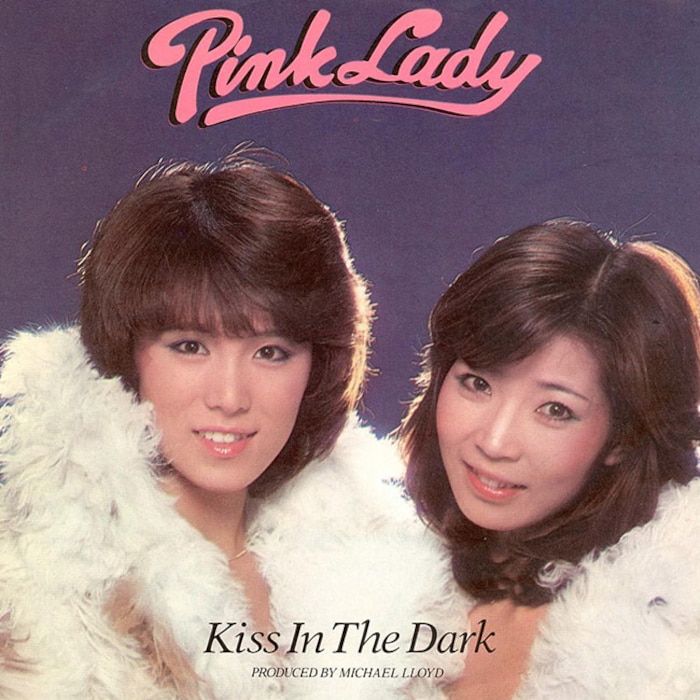
Painted Sunsets
Pink Lady and Sanitised Pop in the 1970s
It was cinema’s small-screen relation, TV, that provided the launch pad for many of the subsequent decade’s squeaky-clean stars. As Mark Schilling writes in his Encyclopedia of Japanese Pop Culture, “in Japan the 1970s was the golden age of the packaged pop star, who rose to fame virtually overnight on the popular prime-time TV music shows and became, for a brief season, as much a fixture on the tube as chocolate bar and instant ramen commercials.”
The all-singing, all-dancing pop pairing of Mitsuyo Nemoto and Keiko Masuda, affectionately referred to as Mii and Kei and publically known as Pink Lady, came up on the Birth of a Star TV talent show. From their first appearance in February 1976, these two effervescent yet unworldly schoolgirls from rural Shizuoka immediately struck a chord in the nation’s hearts. Within six months, the chirpy duo had received a radical makeover, appearing clad in sequinned bikini tops and hot pants, with their trademark meticulously-choreographed yet not-quite-synchronised gyrations set to a relentless disco beat catapulting them to a new level. Their debut single “Pepper Keibu,” released on 25 August 1976 by Victor, reached number four in the Japanese pop charts. The follow-up, “S.O.S.,” released in November, fared even better, initiating a string of nine number ones, including “Nagisa No Sindbad” (Sinbad of the Beach), “Southpaw,” and “Chameleon Army.”

The culmination of this initial all-out assault on the domestic pop charts was the Toho release of Pink Lady The Motion Picture (Pinku redii no katsuo dai shashin, 1978). This gaudy showcase of the girls’ close-unison singing, endearingly stiff dance routines and sanitised sexuality is rather fascinating to modern eyes, although ultimately, director Tsugunobu Kotani serves up a rather lukewarm dish of light entertainment that even at only 83 minutes in length manages to outstay its runtime. An inter-textual mash-up depicting the fictional attempts of the talent agency publicists and record company execs behind the Pink Lady machine at steering them towards an American audience, the film anticipates the similarly scattershot stab at postmodern pastiche of the Spice Girls-vehicle Spice World (Bob Spiers, 1997) some 20 years later.
The movie opens with an aerial shot of New York skyline by night, leading into a press conference of the Kei and Mii gushing about how much they love America and peppering their platitudes with soundbites about their forthcoming movie. What kind of movie it is, no one seems to know yet. This remains in the hands of the producer, publicist and director back in Tokyo, as they struggle to come up with a suitable hook to hang their talent on.
Their pitching sessions form the narrative framework, with the various mooted scenarios embarked upon and subsequently abandoned in thirty minute chunks. The imagined scenes of the unmade opus are intermingled with the girls phoning in from their plush New York hotel suite to check how plans for their big-screen screen debut are proceeding, with excerpts from their hits performed in front of a stadium crowd coming thick and fast every couple of minutes.
The initial pitch of the girls as two flat-sharing sisters living in downtown Tokyo and their various romantic tangles is rejected as too small scale. A science fiction story is proposed involving a giant pink fluffy alien who escapes from a circus where the girls are working (cue the hits ‘Monster’ and ‘U.F.O’). The painted sunset at the coda is emblematic of the fabricated nature of this entire exercise, which purports to lay bare the inner workings of the Pink Lady image factory.
The release of this overblown attempt at capitalising on Pink Lady’s chart success coincided with the burst of their bubble in Japan. None of their subsequent singles – which include “Pink Typhoon,” set to the tune of The Village People’s “In the Navy” with the lyrics reworked in Japanese and substituting the line “Pinku Redii” into the original’s chorus – would never again reach the top of the domestic pop charts.
The girls did indeed attempt to crack an American market that had remained blissfully in the dark as to their massive profile during their meteoric rise in Japan. “Kiss in the Dark,” their one and only single released in the United States, reached only the modest position of #37 in the summer of 1979. Nonetheless, it was the first by a Japanese recording act to make the top 40 since Kyu Sakamoto’s “Sukiyaki” some 16 years beforehand. The pair eventually wound up on the short-lived NBC variety show Pink Lady and Jeff, playing the nubile sidekicks to comedian Jeff Altman in a run that lasted just five weeks in March-April 1980. With much of the humour predicated on the girl’s limited English-language ability, cheery cutesiness and wide-eyed naivety, the widely-panned show did little to elevate record sales on either side of the globe, and Pink Lady returned to Japan where they disbanded in March 1981.
Pink Lady represented one of the last concerted attempts by the Japanese pop music industry to make a dent on the rest of the world for a long time. With the almost complete commodification of pop culture, the idealistic spirit and youthful energy of the early days had long disappeared. As the industry became more hardnosed and cynical, much of the brio of Japan’s pop talent was subsumed by talent agencies for repackaging. Singers and actors alike might migrate between the stage and screen, but cultural boundaries proved less porous, and despite a few notable exceptions, with the dawning of the economic bubble years of the ’80s to its burst in the mid-’90s, mainstream Japanese music would leave as little trace on overseas radars as its cinema.

